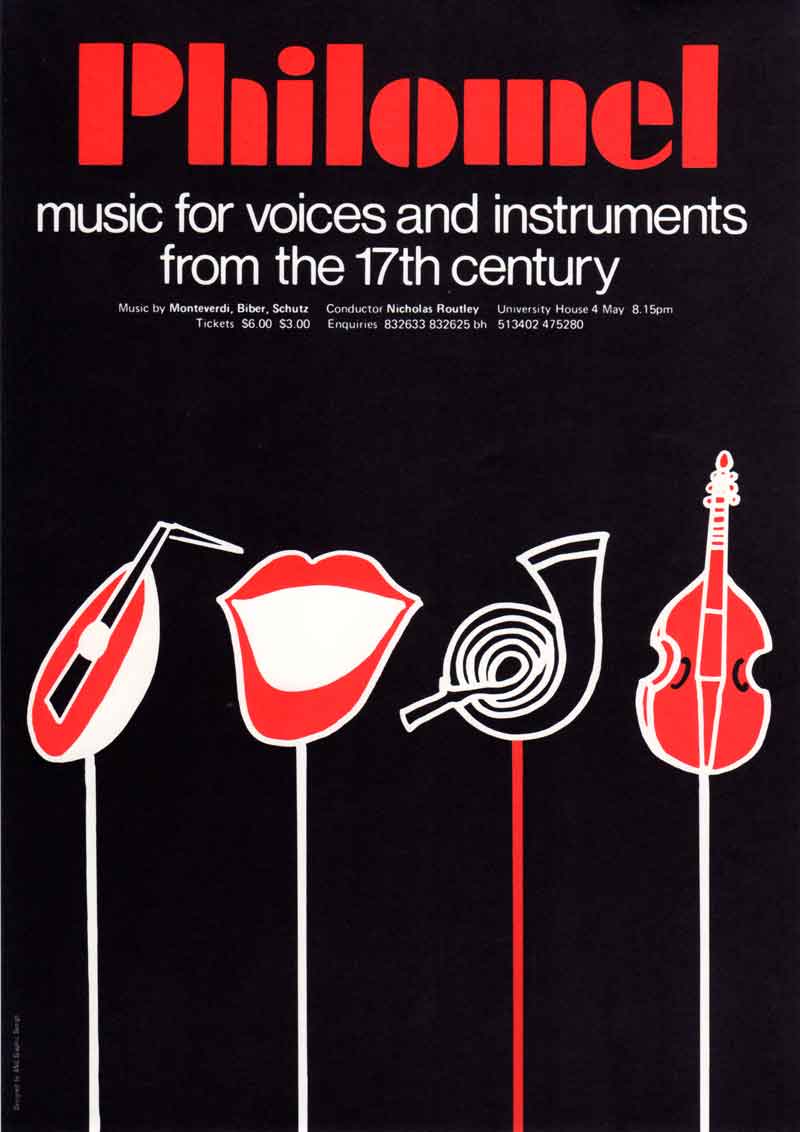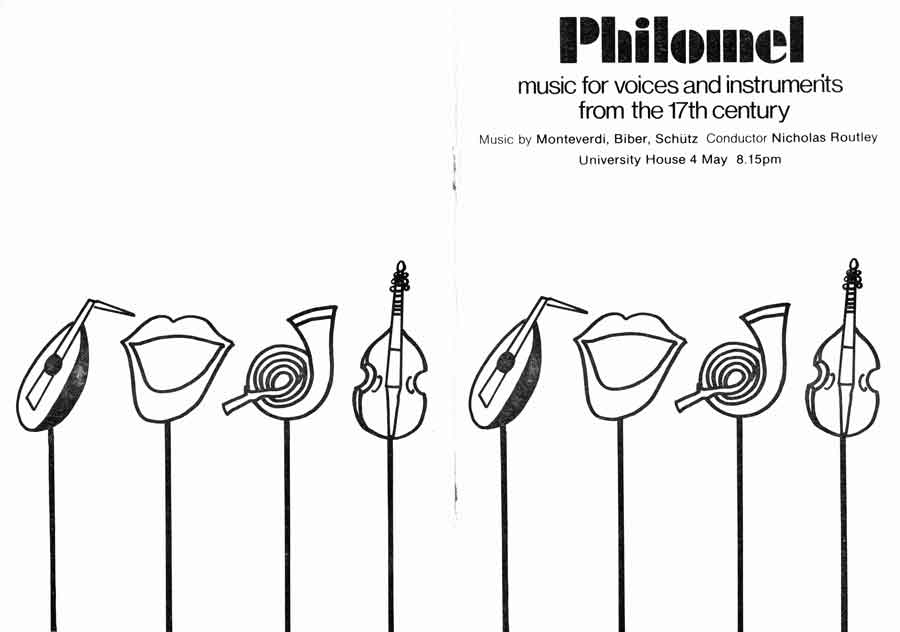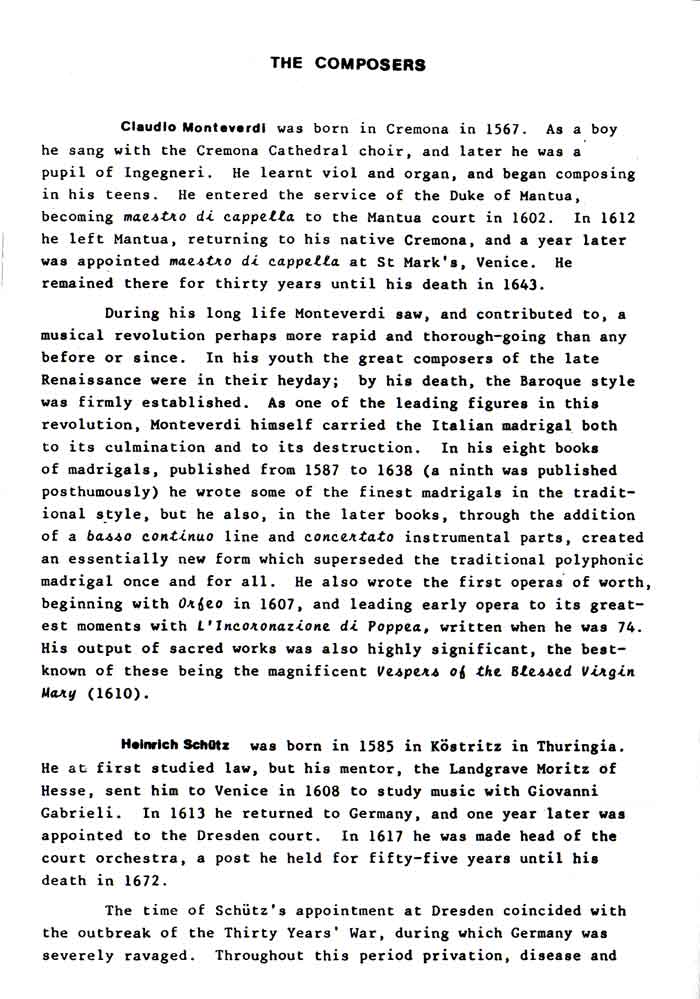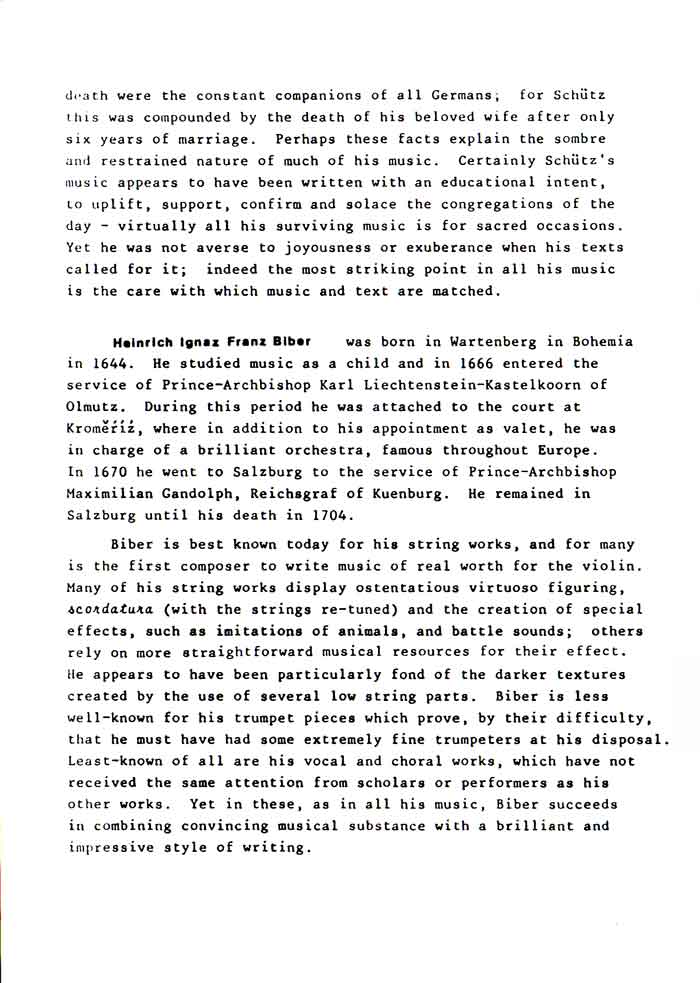
Groups with a link to SCUNA:
Philomel - Concert, 4 May 1980
Part 1
SCUNA history » Groups with a link to SCUNA » Philomel: Part 1
Transcription follows

Transcription
Philomel
music for voices and instruments
from the 17th century
| Music by Monteverdi, Biber, Schutz |
Conductor Nicholas Routley |
University House 4 May 8.15pm |
| Tickets $6.00 $3.00 |
Enquiries 832633 832625 bh |
513402 475280 |
Sideways, bottom left, ascending: Designed by ANU Graphic Design
Description: on a dark navy blue background, the word "Philomel" appears in a large red font. The rest of the text is in white. The lower half of the poster features drawings, on "sticks", of a lute, a smiling/singing mouth, a horn and a viol. They are drawn in red and white and make use of the navy background. Three of the "sticks" are white, but the horn's is red.
Transcription follows

Transcription
Philomel
music for voices and instruments
from the 17th century
Music by Monteverdi, Biber, Schutz Conductor Nicholas Routley
University House 4 May 8.15pm
Description: The programme cover is based on the poster, but with black printing on white. On the front of the programme (right-hand side of the image), the word "Philomel" appears in a large, bold font. "Music for voices and instruments from the 17th century" is in a smaller font, and the rest of the information is printed quite small. Underneath are drawings, on "sticks", of a lute, a smiling/singing mouth, a horn and a viol.
On the back of the programme (left-hand side of the image), the top half of the page is blank, and the drawings appear on the lower half.
Transcription follows

Transcription
Acknowledgements
Burgmann College
Canberra School of Music
Canberra Theatre Centre
John Collis
Daryl Daley
Lindy Hilton
Ann Jeremy
Mrs R. Pillans
St. Philip's, O'Connor
University House
Ian Watchorn
Greta White
We are grateful for financial assistance by the Department of the Capital Territory and for the loan of virginals and portative organ by Dickson College.
Transcription follows

Transcription
The Composers
Claudio Monteverdi was born in Cremona in 1567. As a boy he sang with the Cremona Cathedral choir, and later he was a pupil of Ingegneri. He learnt viol and organ, and began composing in his teens. He entered the service of the Duke of Mantua, becoming maestro di cappella to the Mantua court in 1602. In 1612 he left Mantua, returning to his native Cremona, and a year later was appointed maestro di cappella at St Mark's, Venice. He remained there for thirty years until his death in 1643.
During his long life Monteverdi saw, and contributed to, a musical revolution perhaps more rapid and thorough-going than any before or since. In his youth the great composers of the late Renaissance were in their heyday; by his death, the Baroque style was firmly established. As one of the leading figures in this revolution, Monteverdi himself carried the Italian madrigal both to its culmination and to its destruction. In his eight books of madrigals, published from 1587 to 1638 (a ninth was published posthumously) he wrote some of the finest madrigals in the traditional style, but he also, in the later books, through the addition of a basso continuo line and concertato instrumental parts, created an essentially new form which superseded the traditional polyphonic madrigal once and for all. He also wrote the first operas of worth, beginning with Orfeo in 1607, and leading early opera to its greatest moments with L'Incoronazione di Poppea, written when he was 74. His output of sacred works was also highly significant, the best-known of these being the magnificent Vespers of the Blessed Virgin Mary (1610).
Heinrich Schütz was born in 1585 in Köstritz in Thuringia. He at first studied law, but his mentor, the Landgrave Moritz of Hesse, sent him to Venice in 1608 to study music with Giovanni Gabrieli. In 1613 he returned to Germany, and one year later was appointed to the Dresden court. In 1617 he was made head of the court orchestra, a post he held for fifty-five years until his death in 1672.
The time of Schütz's appointment at Dresden coincided with the outbreak of the Thirty Years' War, during which Germany was severely ravaged. Throughout this period privation, disease and [continued below]
Programme Page 3
Transcription follows

Transcription
[continued from page 3 above] death were the constant companions of all Germans; for Schütz this was compounded by the death of his beloved wife after only six years of marriage. Perhaps these facts explain the sombre and restrained nature of much of his music. Certainly Schütz's music appears to have been written with an educational intent, to uplift, support, confirm and solace the congregations of the day - virtually all his surviving music is for sacred occasions. Yet he was not averse to joyousness or exuberance when his texts called for it; indeed the most striking point in all his music is the care with which music and text are matched.
Heinrich Ignaz Franz Biber was born in Wartenberg in Bohemia in 1644. He studied music as a child and in 1666 entered the service of Prince-Archbishop Karl Liechtenstein-Kastelkoorn of Olmutz. During this period he was attached to the court at Kroměříž, where in addition to his appointment as valet, he was in charge of a brilliant orchestra, famous throughout Europe. In 1670 he went to Salzburg to the service of Prince-Archbishop Maximilian Gandolph, Reichsgraf of Kuenburg. He remained in Salzburg until his death in 1704.
Biber is best known today for his string works, and for many is the first composer to write music of real worth for the violin. Many of his string works display ostentatious virtuoso figuring, scordatura (with the strings re-tuned) and the creation of special effects, such as imitations of animals, and battle sounds; others rely on more straightforward musical resources for their effect. He appears to have been particularly fond of the darker textures created by the use of several low string parts. Biber is less well-known for his trumpet pieces which prove, by their difficulty, that he must have had some extremely fine trumpeters at his disposal. Least-known of all are his vocal and choral works, which have not received the same attention from scholars or performers as his other works. Yet in these, as in all his music, Biber succeeds in combining convincing musical substance with a brilliant and impressive style of writing.
Groups with a link to SCUNA | SCUNA history
Page created 24 October 2013; last updated 01 February 2014
SCUNA: home page | Val: home page





